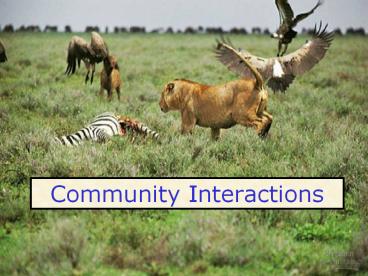Community Interactions PowerPoint PPT Presentation
1 / 28
Title: Community Interactions
1
Community Interactions
2
- Community all the species in a given location
at a given time - Habitat the physical environment they live in
Redwood forest - Niche how a species uses the resources in its
habitat - Builds nest in tree top vs. lower branches
- Similar species coexist by Niche specialization.
3
Competitive exclusion
4
Competitive Exclusion
- The more similar two species niches the more
they compete. - No two species can share the exact same niche-
one dies out. - Species evolve to diverge their niches by
Resource Partitioning
5
Competition for space on the rocks
Weak competitors stuck higher up in the intertidal
6
Resource Partitioning
7
Bristly foxtail
Indian mallow
Smartweed
8
CharacterDisplacement
Two species with same Beak size can not Coexist
on same island
One adaptive result of resource partitioning
9
Types of Interspecific Interactions
Species A Species B
Commensalism 0
Mutualism
Competition - -
Predation -
Parasitism -
10
Predator Prey a Mutualism?
Canadian lynx (dashed line) Snowshoe hares
(solid line)
11
Caulerpa taxifolia suffocating a marine
ecosystem
Do not post on Internet
12
Number of species of ants
Number of species of breeding birds
13
Number of colonizing species of mosses and
vascular plants recorded on Surtsey between 1965
and 1973
14
Keystone species
- Pisaster (Sea Star) defends tide pool from being
taken over by mussels, barnacles.
15
Sea Otters maintain Kelp forest
- Otters are a Keystone species
- Kelp are the base of the kelp forest community
- Urchins eat kelp at their base
- Otters eat urchins, keeping their numbers low.
- Otter numbers along California are dropping.
- Alaska- Orcas starting to eat otters, because
seal numbers are dropping - No fish for seals
16
(No Transcript)
17
SuccessionCommunity Structure changes over time
- Primary Succession starts with no soil, just
bare exposed rock - Progresses in stages until long term climax stage
- Secondary Succession starts with the climax
vegetation type - Disturbance (fire) resets timeline
- Progresses in stages back to climax.
18
2-Barren Rock
1-Glacier Retreats
3-Moss and Lichen
19
4-Cottonwood and Alders
5-Spruce moves in
6-Spruce and Hemlock Climax Vegetation
20
Fire Cycle in Chaparral
21
(No Transcript)
22
Fire poppies in burn area
23
Madrones sprouts from burl
24
Ceanothus seedlings sprout after fire
25
1 month post fire
Schmidts, M.J., D.A. Sims, J.A. Gamon
California State University, Los Angeles, CA
http//vcsars.calstatela.edu/eas_00/miriam/miriam_
esa_00.html
26
First spring 3 years post fire
27
20 and 40 years post fire
28
Mosaic of ages burns

